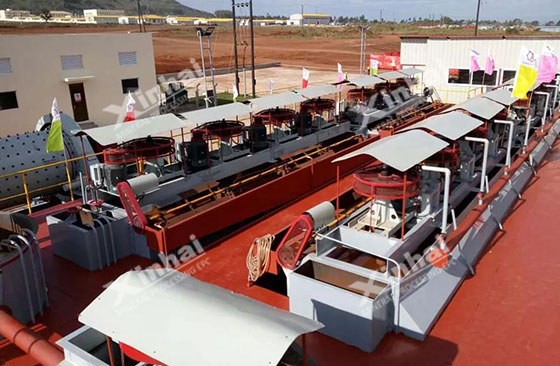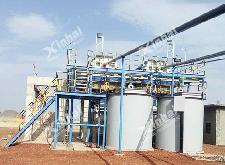

Warm Tip: If you want to know more details about equipment, solutions, etc, please click the button below for free consultation, or leave your requirements!
Here are 5 commonly used froth flotation methods for Pb-Zn sulfide ore extraction:
Priority froth flotation method
Mixed froth flotation method
Iso-flotation method
Differential branching flotation method
Potential-controlled flotation method
The Pb-Zn sulfide ore is often associated with a variety of valuable components, such as lead, zinc, copper, sulfur and other useful minerals, whose floatability is obviously different, which determines the different froth flotation method used in the extraction of lead and zinc sulfide ores.
If you want to select which one is suitable for your mine, you're in the right place.

The flow of lead and zinc priority froth flotation method is mainly to suppress zinc first and float lead, then activate zinc to get lead concentrate and zinc concentrate. According to the buoyancy degree of lead zinc ore, the valuable minerals, such as lead and zinc, can be recovered successively by the froth flotation method.
The priority froth flotation method is suitable for rich ores with simple mineral composition, high lead and zinc content, and coarse disseminated ores. It is also suitable for dense massive sulfide ores with a large number of sulfide ores. It has the advantages of easy to control, high concentrate quality, small fluctuation of the flotation index.
The mixed froth flotation method used in the extraction of lead and zinc sulfide ore are to float the mixed concentrate of lead and zinc sulfide first, and then separate the mixed concentrate of lead and zinc sulfide. That is, all lead sulfide and zinc sulfide minerals are first separated into the mixed concentrate, and then the mixed concentrate is separated individually after the reagent removal, and the single flotation concentrate is obtained.
The mixed froth flotation method can discard a large number of gangue minerals after rough grinding, which reduces the processing capacity of subsequent operations, saves the reagents dosage used in the separation stage, reduces the energy consumption. It is suitable for treating the lead-zinc ores with little difference in floatability, low grade, and the useful minerals are the aggregation or dense coexistence.

The iso-flotation method used in the extraction of lead-zinc sulfide ore is to divide the lead and zinc sulfide ore with similar floatability into two parts: easy-to-float part and difficult-to-float part. Then the mixed concentrate is obtained by the mixed froth flotation method, which is separated as the single concentrates of various useful minerals successively.
In some ore dressing processes, some sphalerite has a close flotability with galena, a few parts of galena have and a close flotability with most sphalerite. Therefore, make full use of different flotability between lead and zinc ore, and make a part of zinc ore with good flotability floated in the lead flotation method, and the rest of lead ore is floated along with the zinc flotation method.
Finally, the mixed concentrate of lead and zinc is separated, which can be separated again by the froth flotation method to obtain the lead concentrate and zinc concentrate respectively.
The iso-flotation method is suitable for the lead-zinc sulfide ore whose useful minerals containing easy-to-float and difficult-to-float ore. This method has the advantage of a mixed froth flotation method and priority flotation method. It can reduce the reagent dosage, eliminate the drug adverse impacts on the flotation separation, improve the quality and recovery rate of concentrate. But the iso-flotation method has relatively complex flow, takes long flotation time and much flotation cell.
The differential branching flotation method used in the extraction of lead-zinc sulfide ore is to quickly float the lead zinc ore which can be floated fast and easily, and then float the lead zinc ore which is floated slowly and difficultly.
This froth flotation method is applicable to lead and zinc sulfide minerals with different flotation behaviors due to different inset components, which can obtain the better flotation indexes while reducing the configuration volume of the flotation machine, reduce metal circulation and loss, decrease the flotation reagent consumption and simplify the process flow.

Potential-controlled flotation method used in the extraction of the lead-zinc processing is to change the electrochemical conditions of flotation system to control the process and direction of oxidation-reduction reaction on the surface of the sulfide minerals in the slurry system, thus affecting the surface state of sulfide ore, the product form and stability of collector on the surface of sulfide ore, increasing the hydrophilic and hydrophobic properties of sulfide ore surface, so as to achieve the flotation separation of sulfide mineral.
The potential-controlled flotation method is characterized by low reagent dosage, simple formulation, little environmental pollution and high selectivity, especially suitable for the separation of low-grade lead-zinc sulfide ore.
You should know more about each kind of flotation method after reading this post. But for the complexity of lead-zinc ore, it is suggested that each mine owner should adopt the scientific and reasonable froth flotation method according to the report of the mineral processing test report from Pro Mineral Dressing Test Company, avoiding the unnecessary economic loss.
Last: 5 Factors Affect Vibrating Screen Efficiency
Next: What Factors Should be Considered in Choosing Grinding Machine?


What Are the Differences Between CIP and CIL?
 11347
11347
 0
0